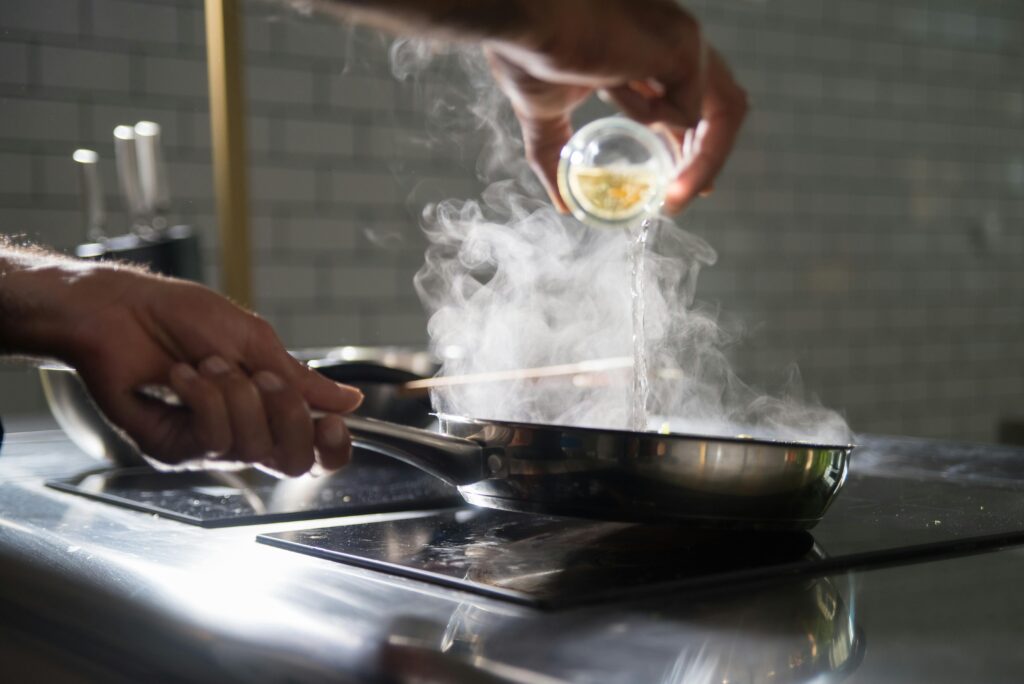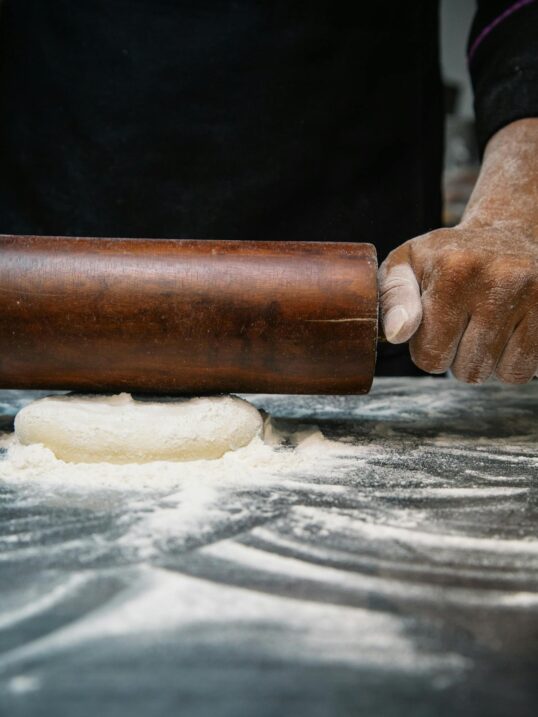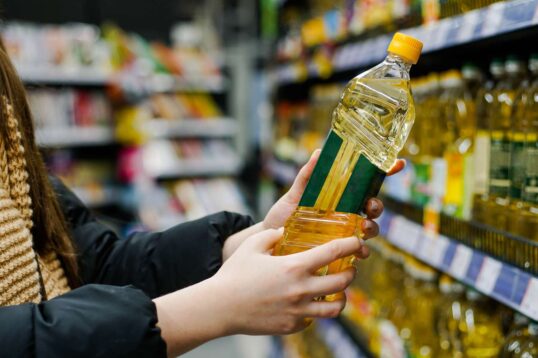Success in any field depends greatly on the tools you use. For cooking, this means having the right cookware, utensils, and appliances. Even the most experienced chef can be a fish out of the water in a poorly equipped kitchen.
Given the abundance of cookware types, materials, and brands, figuring out what works best for your needs can be challenging. To start, it’s advisable to invest in a skillet, a saucepan, and a larger stock pot.
The next thing on the list is to choose between different cookware materials in the market. Stainless steel, nonstick, cast iron, and carbon steel are popular materials to consider.
Each material has its pluses and minuses. In this article, we will take an in-depth look at stainless steel vs nonstick pans. By the end of this article, you will have gained a deeper understanding of their construction, performance, maintenance, and suitability for different cooking methods.
What Are Stainless Steel Pans?
Let’s dive into the nitty-gritty of stainless steel to better understand its role in modern cooking.
Construction and Materials
Stainless steel is an alloy of iron that contains carbon, chromium, and nickel. Although there are various grades of stainless steel, the type commonly used for cookware contains 18% chromium and 8% nickel, also known as 18/8 stainless steel or 304 stainless steel.
18/0 stainless steel or 430 stainless steel is another variant that contains 18% chromium and 0% nickel.
Chromium makes stainless steel corrosion-resistant, which is essential in cookware. Nickel, too, contributes to corrosion resistance, while also making stainless steel easier to form into shapes and suitable for high-temperature cooking.
It is important to note that adding nickel demagnetizes stainless steel in most cases, which means you cannot use such cookware on induction cooktops.
Common Manufacturing Processes
Stainless steel cookware is made by fusing multiple layers of steel with a thermally conductive material such as aluminum or copper. This is necessary because steel is a poor conductor of heat.
Manufacturers sandwich a layer of aluminum or copper between two layers of stainless steel and bond these layers together under high heat and pressure.
This process, known as cladding, produces a single sheet of metal that combines the durability and heat retention properties of steel with the excellent heat transfer capabilities of aluminum and copper.
Stainless steel can be 3-ply or 5-ply, depending on the number of layers fused together; this is usually indicated on the cookware packaging. 5-ply stainless steel takes longer to heat up and cool down than 3-ply and weighs more. That said, 5-ply cookware offers more uniform heating, is more resilient to warping, and gives cooked food a better finish.
Another crucial factor to consider, more significant than the number of layers, is the type of cladding — fully clad vs. clad.
With fully clad stainless steel, you get the advantage of cladding not just on the base of the cookware but all the way up its walls. This prevents food from scorching and promotes uniform cooking.
To ensure your cookware is fully clad, steer clear of pans that mention ‘clad’ (as opposed to ‘fully-clad’), ‘disk-bottom’, or ‘aluminum-encapsulated base’, terms that indicate the cladding is limited to the base of the pan.
Price Range and Durability Expectations
Stainless steel cookware is extremely durable and lasts a lifetime under proper care.
High-quality stainless steel cookware can be expensive, with 5-ply pans costing up to twice as much as 3-ply pans. Similarly, fully clad cookware comes at a higher price point than clad ones, in which heating is restricted to the cooking surface. Pricing also varies by manufacturer.
For instance, a 3-ply, 10-inch stainless steel frying pan from All-Clad costs around $100, whereas you could grab a similar pan from Zwilling for less than $75.
Similarly, you can get a 3-ply, 3-qt stainless steel saucepan from All-Clad for around $120 and from Zwilling for less than $100.
What Are Nonstick Pans?
A nonstick pan has a special coating on its cooking surface that prevents food from sticking to the pan. This is quite helpful if you are frying eggs or certain types of fish or preparing sticky sauces, as the food releases easily without breaking up and leaving a sticky mess to clean up afterward.
Let’s look at the features of nonstick pans in a bit more detail.
Types of Nonstick Coatings
The secret of a nonstick pan lies in its coating. The two popular types of coating in use today are Teflon and ceramic.
Teflon is the trademark name for a compound called PTFE (Polytetrafluoroethylene), which is a material known for its nonstick, non-reactive, and insulative properties.
Nonstick pans have a coating of Teflon bonded to a base usually made from aluminum. Teflon imparts nonstick properties to cookware, doesn’t react with acidic liquids or sauces, and remains stable at high temperatures of up to 500°F.
Another type of nonstick coating seen in pans is the ceramic coating. While it isn’t truly made from ceramic, the coating contains silica and other inorganic compounds that are sprayed and baked onto cookware made from aluminum, stainless steel, or cast iron.
The coating makes cookware nonstick and non-reactive to acidic ingredients.
Ceramic-coated cookware gained popularity in the early 2000s as Teflon cookware came under scrutiny owing to suspected health and environmental concerns. However, there is no proven study that establishes one as safer than the other.
Common Brands and Varieties
Top manufacturers of Teflon nonstick cookware include Calphalon, Made In, Cuisinart, and All-Clad.
The difference between these brands lies in the base material used to manufacture their nonstick cookware. While Calphalon typically uses hard-anodized aluminum, Made In sticks to a stainless steel base (no pun intended!). All-Clad offers both types.
Moreover, nonstick pans from Made In and the nonstick, stainless steel cookware from All-Clad are compatible with induction cooktops in addition to gas and electric ones.
All brands claim their Teflon-coated cookware is oven-safe up to 500°F, although their lids can safely take only up to 350°F.
In the ceramic-coated nonstick segment, GreenPan and Caraway are popular brands. With a hard-anodized aluminum base and an add-on layer that makes the cookware induction-friendly, these nonstick pans can easily be used up to 550°F.
Typical Lifespan and Price Ranges
Teflon nonstick pans are generally more durable than their ceramic counterparts. While you can expect to use a Teflon pan for a couple of years under proper care, ceramic pans can only be used for up to six months to a year, after which they begin to lose their nonstick properties.
A Teflon-coated, 5-ply stainless steel, 10-inch frying pan costs around $130 from All-Clad and Made In, whereas a 10-inch Teflon pan (with a hard-anodized aluminum base) from Calphalon comes cheaper at $70.
Ceramic-coated nonstick pans are not too far behind. Marketed as PTFE-free cookware, a 10-inch aluminum-base pan from Caraway could cost up to $100 and around $70 from GreenPan.
Stainless Steel vs Nonstick Pans
Let’s analyze the strengths and weaknesses of stainless steel and nonstick pans in a one-to-one comparison of the factors most significant to the end user.
Cooking Performance
Stainless steel pans are suitable for frying, searing, sauteing, and braising. However, you will need generous quantities of oil or butter to prevent food from sticking to the pan and achieve a nice sear.
By comparison, nonstick pans are suitable for frying and sauteing and can be used with little to no added fat. However, if you like your fried eggs or pancakes slightly crispy, you will still need to use butter or oil.
Stainless steel cookware is best used when you want to achieve a well-browned crust on a steak (due to the Maillard reaction) or create fond that you can deglaze to create an exquisite sauce.
On the other hand, nonstick cookware is best suited for frying eggs or fish, making pancakes, preparing thick sauces, or cooking anything that aggressively sticks to the pan.
For dishes that need to go into the oven to finish, you are better off using stainless steel, as nonstick pans aren’t generally suitable for high-heat cooking. Even if the manufacturers claim their nonstick pans can be safely used up to 500°F, the nonstick coating runs the risk of degradation over time with consistent, high-temperature cooking.
Maintenance and Care
Post-cooking cleanup might seem harder with stainless steel, but being naturally resilient to abrasion or wear and tear, it doesn’t need much TLC.
This means you can safely put your stainless steel pots and pans in the dishwasher, after scrubbing off stuck food.
By contrast, you must always handwash your nonstick pans with a gentle detergent and sponge to preserve the nonstick coating. Thankfully, a nonstick pan in good condition is rather easy to clean.
While you can use any type of utensil with stainless steel pans, you must only use non-metallic (silicone, wood, or nylon) utensils with nonstick pans.
Price and Durability
A high-quality, stainless steel pan from a reputed manufacturer will cost more than a nonstick pan, more so if the latter has an aluminum base.
However, stainless steel cookware is built to last, which means you won’t have to replace it, whereas nonstick pans can only last a year or two of constant use.
Given their durability, stainless steel offers a better bang for your buck.
Health and Safety
This is a major factor that swayed users toward ceramic-coated cookware. However, there isn’t enough research to establish that ceramic coatings are safer than PTFE. Here’s what you should know.
PTFE and PFOA (Perfluorooctanoic acid) belong to a class of chemicals called PFAS (Per- and Polyfluoroalkyl Substances) and are dubbed ‘forever chemicals’ because they do not break down naturally.
Since 2013, all Teflon manufacturing has been PFOA-free. This followed multiple studies that demonstrated PFOAs as posing a reasonable health risk to humans.
PTFE is a chemically and biologically inert substance whose only proven side effects occur due to incorrect usage of Teflon cookware. This happens when the Teflon cookware is heated when empty at high temperatures, causing it to release toxic fumes.
Inhaling these fumes can result in flu-like symptoms, which disappear in 1-2 days.
Both Teflon and ceramic-coated cookware must be replaced when their coating begins to chip off. With low-quality ceramic-coated cookware in particular, this could result in harmful metals leaching into your food. A stainless steel base prevents this (you should still replace it).
Buyer’s Guide: Which Pan Is Right For Me?
If you are starting out, we recommend investing in a 3-ply, 12-inch stainless steel frying pan and a 10 or 12-inch nonstick pan.
It helps to remember that these two cookware types serve different cooking purposes and hence, both can have a place in your kitchen.
Stainless Steel
Think of stainless steel cookware as a heavy-duty kitchen workhorse better suited for sauteing vegetables, preparing soups and stews, boiling pasta, frying diced chicken, and searing a nice steak.
With stainless steel, you can crank up the heat when cooking, toss it into the oven to finish off a recipe and load it into a dishwasher for hands-free (sort of) cleaning.
Nonstick
A nonstick pan is what you should reach out for when pancakes are on the menu. The same goes for eggs (scrambled or sunny-side up), delicate cuts of fish that can otherwise fall apart, a quick avocado toast, or even fried tofu.
Avoid using nonstick cookware at extremely high temperatures, in the oven, or the dishwasher.
Remember the more often you use it, the greater the chances of scratching the coating. So, while it can be tempting to pull out the nonstick pan for everything, we’d advise you to save it for when it’s most needed.
Care and Maintenance Tips
Here are our top tips to make your stainless steel and nonstick cookware last for as long as possible.
Stainless Steel Care
The gentlest way to clean stainless steel cookware is to handwash it thoroughly using a scrubber and dish detergent. Avoid steel scourers if you want to keep the cookware free of scratches.
While scratches may diminish its shine, they do not have any functional effect on the stainless steel cookware.
You can also use a dishwasher to clean stainless steel pans. Remember to remove any stuck bits of food before tossing it in.
PRO TIP: One of our tried and tested techniques to release burnt/stuck food from stainless steel cookware is to soak the pan in a mixture of hot water, baking soda, and vinegar/lemon. Let sit for a few minutes before scrubbing it off. This also works well to remove stains.
We’ll let you in on another secret: you can turn a stainless steel pan effectively nonstick by allowing it to heat up for a bit before adding any food. To check if it’s hot enough, drizzle a few drops of water onto the pan. If the drops jump around before evaporating, you’re ready to start cooking. Don’t forget to add some oil or butter!
Another best practice when cooking is to avoid flipping food before it gets done. Food tends to stick more when it’s not fully done.
Once you’re done cooking, resist the urge to place a hot stainless steel pan directly under running water to quicken things up. Doing this could warp your cookware due to thermal shock. The same applies to sticking a cold piece of cookware inside a preheated oven.
Nonstick Care
Make sure you follow the manufacturer’s guidelines on safe cooking temperatures for your nonstick cookware.
While a good-quality nonstick pan can safely go up to 500°F, consistently using the pan at such high temperatures can eventually compromise the nonstick coating. Once the coating begins to chip off or degrade, it only gets worse. So, you always want to stay in the low-medium heat range. You should also not heat your nonstick pan empty for too long.
Remember to use utensils made of wood, silicone, or nylon, and avoid metal ones.
Avoid using nonstick cooking sprays as they adhere to the nonstick coating and reduce its performance over time.
As with stainless steel, you should never place a hot nonstick pan right off the stove into a washing sink. Allow it to cool down to the ambient temperature. This improves the longevity of the nonstick coating.
Always handwash your nonstick cookware using a gentle scrubber (a sponge is ideal) and detergent. Avoid stacking nonstick cookware so they don’t get accidentally scratched.
When to Replace a Stainless Steel or Non-Stick Pan
With proper usage, the chances of ruining a stainless steel pan are close to nil. However, if you notice your pan has significant warping that affects its ability to sit securely on a stove or heat food uniformly, you should replace it.
In disk-bottom stainless steel pans (that have a disk made from aluminum or copper), the disk attached to its base might detach eventually. This can only happen with poor-quality stainless steel cookware (unlike the 3-ply or 5-ply bonded stainless steel). If this happens, you need to replace your pan right away.
A nonstick pan is already on its decline when you notice small scratches or marks on an otherwise smooth surface. Following the care tips above will help keep your nonstick cookware in top shape for a long time.
However, if you notice that food increasingly sticks to your nonstick pan and doesn’t release easily if you skimp on oil or if the cooking surface has turned rough, it is definitely a red flag that means it’s time to replace your nonstick pan.
Insider’s Insight
Stainless steel cookware are sturdy kitchen workhorses you can use to fry, saute, boil, braise, or sear food. While they aren’t nonstick, stainless steel can withstand high temperatures, and go in the oven, dishwasher, and refrigerator.
Nonstick cookware is suitable for low-medium temperature cooking, can be used with little to no oil, and must always be gently hand-washed to last long. You must only use wooden or silicone utensils with nonstick pans. They aren’t dishwasher safe and their coating can chip if improperly used.
We recommend having one of each – a nonstick pan for foods that tend to stick and a stainless steel one for regular use.
FAQs
Can stainless steel become nonstick?
To some extent. If you heat a stainless steel pan just right, so that a few drops of water sprinkled on the surface dance around before they evaporate, food tends to stick less. You also need to wait a sufficient time before attempting to flip or toss the food around. However, stainless steel cannot have the same performance as nonstick-coated cookware.
Are nonstick pans safe?
Nonstick pans are safer today than they used to be before 2013 when PFOA (perfluorooctanoic acid) was used in the manufacturing process. Teflon is a chemically and biologically inert substance that doesn’t interact with food and is safe to use. However, if you heat an empty nonstick pan for too long, it could release fumes that cause temporary, flu-like symptoms.
Both Teflon and ceramic-coated cookware must be disposed of if their coating starts to chip.
Which is better for beginners?
Nonstick pans are generally easier to handle. That said, both nonstick and stainless steel serve different cooking purposes, so it is essential to have one of each. Also, while stainless steel is resilient to damage, nonstick coatings are easily compromised with rough use.
Can each pan go in the dishwasher?
Stainless steel pans are dishwasher-safe. Nonstick pans must never be used in a dishwasher.
How long should each type last?
Stainless steel cookware can last a lifetime if used properly. Nonstick pans generally last between 1-2 years.




Leave a Reply